- OgreOgress Productions
- Airat Ichmouratov
- John J Becker
- Bizet: Carmen
- Arrigo Boito
- From the New World
- Schleswig-Holstein
- Cleo Lane
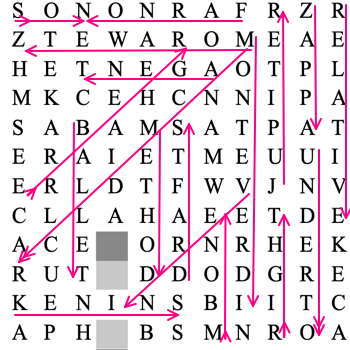 WORD SEARCH: Can you solve Allan Rae's classical music word search puzzles? We're currently publishing one per month.
WORD SEARCH: Can you solve Allan Rae's classical music word search puzzles? We're currently publishing one per month.
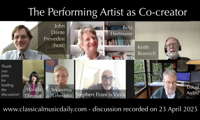 DISCUSSION: What is a work? John Dante Prevedini leads a discussion about The performing artist as co-creator, including contributions from Halida Dinova, Yekaterina Lebedeva, Béla Hartmann, David Arditti and Stephen Francis Vasta.
DISCUSSION: What is a work? John Dante Prevedini leads a discussion about The performing artist as co-creator, including contributions from Halida Dinova, Yekaterina Lebedeva, Béla Hartmann, David Arditti and Stephen Francis Vasta.
Gesualdo and Friends
GIUSEPPE PENNISI listens to Les Arts Florissants
Last summer, a concert held, as part of the Pontino Festival, at Castello Caetani in Sermoneta, was reviewed in this magazine. The concert included madrigals by Carlo Gesualdo da Venosa (1566-1613), a unique historical character both as a very rich prince in the Kingdom of Naples and as a musician. At that time, musicians normally worked for the aristocracy and the aristocrats did not compose. Thus, the books of madrigals published by Gesualdo were signed under pseudonyms. Gesualdo is also known for a fact of blood: he killed his first wife and her lover when, returning home from a hunting game, he found them in his bed. He had to flee to Ferrara, because the families of the murdered couple wanted to slaughter him. There he married the Duchess Eleanor of Este and stayed for a long time in Ferrara.
Already in Naples, Gesualdo had been in contact with great Italian and Flemish musicians and with great poets such as Torquato Tasso. However, the lively Ferrara artistic environment gave new impetus to his art. There he composed his Fourth Book of Madrigals, in 1596. In the texts and in the music always very tormented and gloomy, it is seen the reflection of the tragic fact of blood that marked his life. Nonetheless, this is a modern interpretation, because the aesthetic conceptions of the era did not foresee mixing between life and art. He met the musical world of Northern Italy. He returned to his castle and lived the rest of his life there with his retinue and servants and with equipment to print musical scores. His music was played in the Castle only for his friends.
Gesualdo was forgotten for almost four hundred years when Igor Stravinky rediscovered him in the 1960s. In Stravinsky's words: Gesualdo is a planet without satellites and a composer with neither father nor children. Glenn Gould compared him to Bach. Living at the turn of the sixteenth and seventeenth centuries, Carlo Gesualdo Prince of Venosa is one of the most original and brilliant musicians of all time and a key figure of the transition from the Renaissance to the Baroque. He used vocal polyphony, which represents the culmination of Renaissance music, to express the contrasting affections and taken to the extreme of Baroque. He used dissonances and chromaticism not allowed by the rules of the time, thus anticipating by more than two centuries the subsequent developments of music.
His madrigals are very chromatic and include incredible modulations. They are based on the contrast of unrelated harmonic blocks. In his vocal writing, there are real jumps of intervals and difficult intonation. They are also very sensual, almost carnal. They mirror a tormented person. In addition, words and music blend expertly and aim at the expression of feeling rather than the description of a situation or landscape. Their emphasis is on suffering and death.
This diversity from the music of the time may be one of the reasons why his experiments were not continued by other composers of the time. This is one of the reasons why Gesualdo's madrigals are so modern. They have attracted many contemporary composers: for example, a work on Gesualdo by Alfred Schnittke was presented in 1995 at the Vienna Staatsoper and had several productions in Europe. The opera Luci Mie Traditrici by Salvatore Sciarrino is largely inspired by Gesualdo's life and music.
The Istituzione Universitaria dei Concerti (IUC) of the University of Rome La Sapienza began last autumn a Gesualdo Project spread over two seasons. I could not attend the first concert on 15 October 2019, but I was at the second, Saturday 15 February 2020 in the Aula Magna of the University with the Fourth Book of The Madrigals performed by Les Arts Florissants with the direction of Paul Agnew. The project features a series of lectures, book presentations and other events around the execution of Gesualdo's Madrigals by Les Arts Florissants, who are bringing those masterpieces to Europe - Paris, Madrid, Seville, Essen and other cities - and to America - New York.
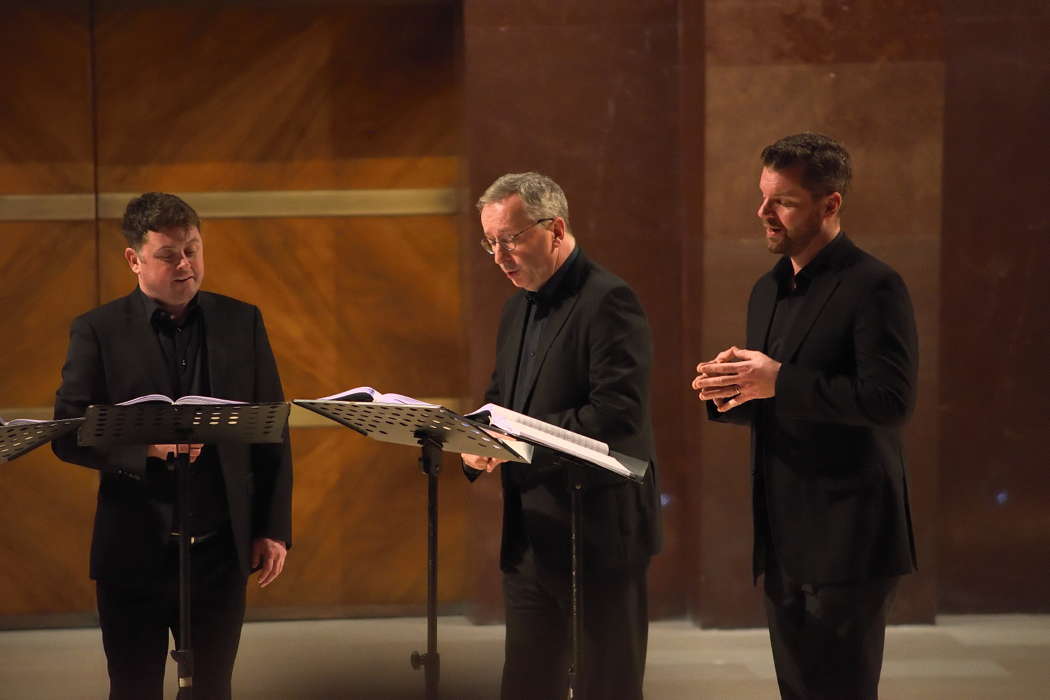
Members of Les Arts Florissants performing in Rome. From left to right: Sean Clayton, Paul Agnew and Edward Grint. Photo © 2020 Claudio Rampini
Although sponsored mostly by a French bank and by French local authorities, Les Arts Florissants is mostly a British ensemble which, in 2019, celebrated forty years of activity. It was founded by Sir William Christie. In 2013, he associated Paul Agnew with the leadership of the group. It is one of the first and most reputed international groups in the field of Renaissance and Baroque music, performed faithfully rebuilding the original modes. Its activity embraces vocal and instrumental music, concertos and opera. In this concert, in addition to Paul Agnew, tenor and director of the ensemble, the singers were the sopranos Miriam Allan and Hannah Morrison, the alto Lucile Richardot, the tenor Sean Clayton and the bass baritone Edward Grint.
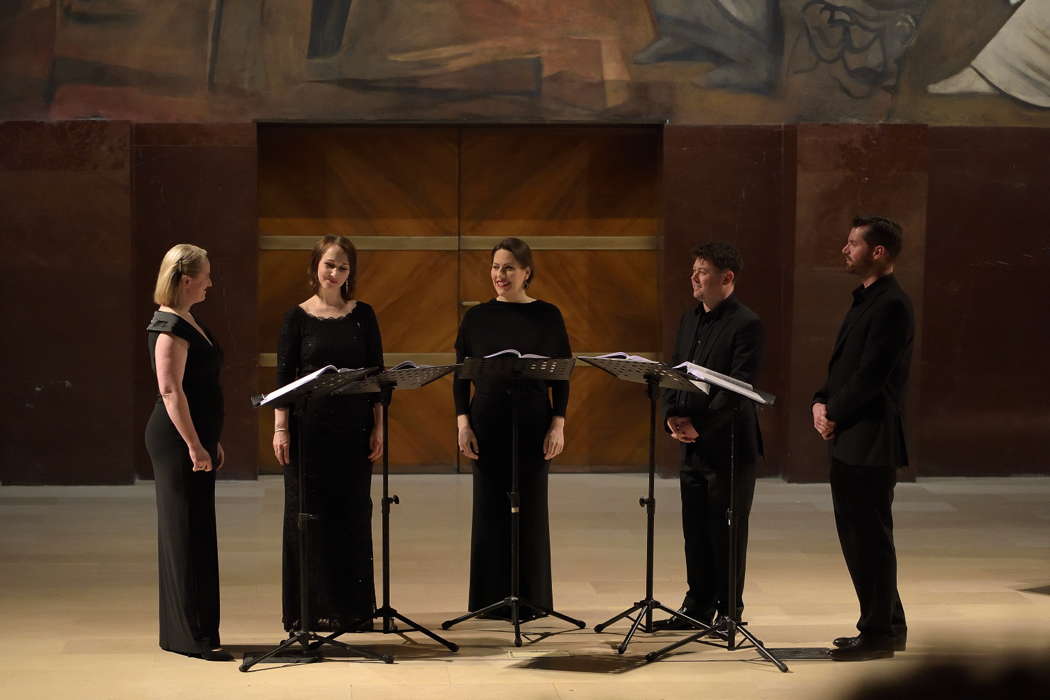
Les Arts Florissants performing in Rome. From left to right: Miriam Allan, Hannah Morrison, Lucile Richardot, Sean Clayton and Edward Grint. Photo © 2020 Claudio Rampini
The program included, before the complete reading of Gesualdo's Fourth Book of Madrigals, the performance of some madrigals and motets by other great composers - Nicola Vicentino, Luca Marenzio, Luzzasco Luzzaschi, Claudio Monteverdi and Orlando Di Lasso - who were more or less contemporary with Gesualdo. This allows for a better grasp of Gesualdo's uniqueness. Take, for example, the madrigal Luci Serene e Chiare, based on a sonnet by Ridolfo Arlotti: Monteverdi's version is bright and serene; Gesualdo's is troubled and full of suffering.
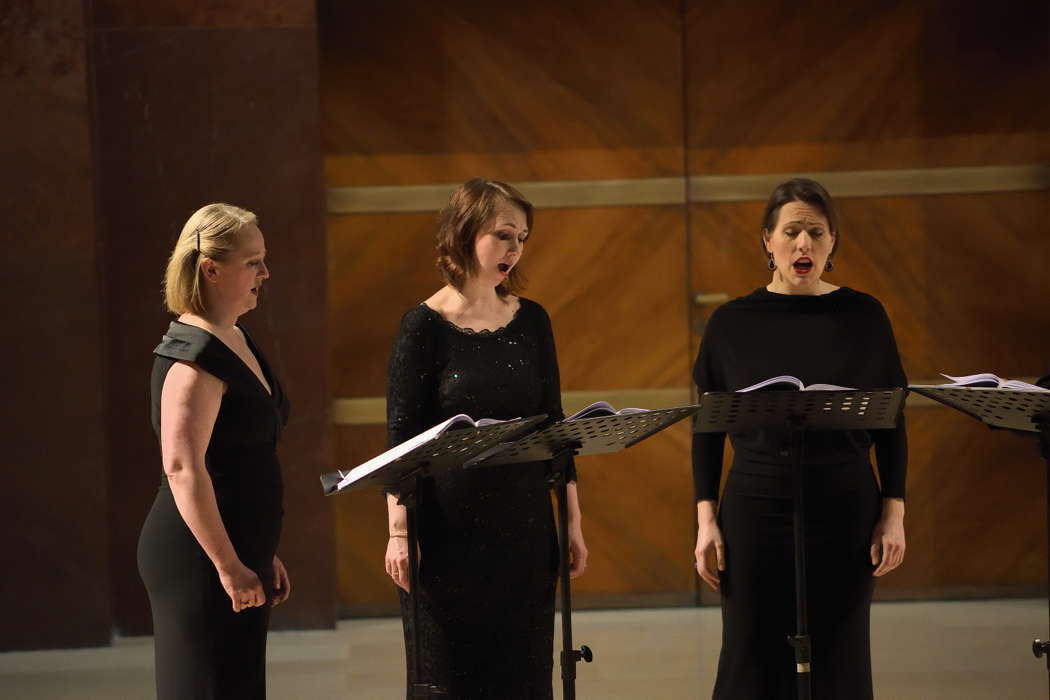
Members of Les Arts Florissants performing in Rome. From left to right: Miriam Allan, Hannah Morrison and Lucile Richardot. Photo © 2020 Claudio Rampini
The concert proved once again that Les Arts Florissants is a perfect ensemble for Gesualdo's music as well as for that by his near contemporaries, especially in highlighting a refined and complex chromaticism that would become the mainstay of the music only much later, in the late Romantic period. The concert hall has a thousand seats; it was full. The audience applauded after each madrigal and thanked Les Arts Florissants with ovations at the end of the concert. Les Arts Florissants responded with an encore of a madrigal from their collection.
Copyright © 17 February 2020
Giuseppe Pennisi,
Rome, Italy

FURTHER INFORMATION: CARLO GESUALDO DA VENOSA


